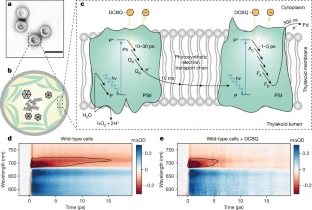Science Daily March 22, 2023
Previous approaches to ‘re-wire’ photosynthesis for higher biomass-conversion efficiencies and new reaction pathways have focused on charge extraction at terminal electron acceptors of the photosystems. Electron extraction at earlier steps, perhaps immediately from photoexcited reaction centres, would enable greater thermodynamic gains. Using in vivo ultrafast transient absorption (TA) spectroscopy an international team of researchers (UK, Finland, Germany) demonstrated the extraction of electrons directly from photoexcited PSI and PSII at early points (several picoseconds post-photo-excitation) with live cyanobacterial cells or isolated photosystems, and exogenous electron mediators. They postulated that these mediators oxidize peripheral chlorophyll pigments participating in highly delocalized charge-transfer states after initial photo-excitation. According to the researchers their results challenged previous models that the photoexcited reaction centres are insulated within the photosystem protein scaffold, and opened new avenues to study and re-wire photosynthesis for biotechnologies and semi-artificial photosynthesis… read more. TECHNICAL ARTICLE

Exogenous electron mediator acts on the pico-second timescale in living cells. Credit: Nature (2023)